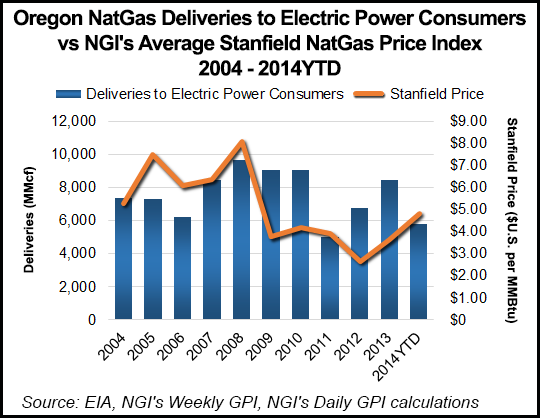Markets | Infrastructure | NGI All News Access | Regulatory
More Gas Generation, Low Gas Prices in PGE’s Future, CEO Says
Portland General Electric (PGE) has more than a billion dollars worth of new generation coming to fruition in the next two years, and $750 million is tied up in two new natural gas-fired plants, according to PGE CEO Jim Piro.

During a quarterly conference call on Tuesday, PGE reported 3Q2014 net income of $39 million (47 cents/share), compared with $31 million (40 cents) in 3Q2013.
Piro said three major generation plant projects are on time and on budget.
The $300 million 220 MW Port Westward Unit 2 gas-fired project in Columbia County is set to be placed in service in the first quarter of 2015. Construction is also in full swing at the $450 million, 440 MW gas-fired Carty Generating Station at Boardman, OR, on the site of a coal-fired plant that is slated to be shuttered. Carty is scheduled be operational in mid-2016.
Piro noted that those projects and a $500 million 267 MW wind project, Tucannon River, are developing in a general service territory economy that is beginning to grow again. PGE saw a 4.7% increase in energy deliveries in 3Q2014, compared with 3Q2013. “We continue to see positive economic trends in our service area, and these trends are translating into growth in all sectors, but particularly the commercial/industrial sectors,” he said.
Port Westward’s Unit 2 is being test-fired, and it will be ready to go early next year to help PGE better manage load requirements and integrate more renewables into the grid, Piro said. He said that engineering design work on Carty is being completed and foundation work continues for the gas and steam turbines. It is being built as a baseload facility.
Combined with the wind project, the two gas facilities will boost PGE’s rate base by $1.2 billion in 2017, at which time the utility’s overall rate base is expected to be $4.5 billion.
In response to a question about PGE’s 90% interest in the 585 MW Boardman coal-fired generation plant that will be retired in 2020 and the added generation that will be needed at that time to replace it, Piro said it will be addressed in the utility’s next integrated resource plan (IRP). “There is a lot of interest in gas and renewable projects to replace Boardman,” he said. “To the extent that we add more wind resources, we will have to look at additional gas-fired generation.”
Regarding the future role efficiency programs will play in the power mix, Piro said the utility continues to work with state officials, looking at forward supply curves, which he saw being impacted by low gas prices. Over time unless there are marked technology advances there will be diminishing returns from efficiency, mostly because of the lower gas prices, Piro said.
“In the low gas price environment, many measures don’t become economic,” he said. “It is something we will be evaluating in our next IRP update.”
© 2024 Natural Gas Intelligence. All rights reserved.
ISSN © 1532-1231 | ISSN © 2577-9877 |
